6. Latin America and the Caribbean
Latin America and the Caribbean region is an enormous market, having a population of 600 million and a regional GDP of approximately $6 trillion (2014). The region has steadily increased its presence in the international community through the consolidation of democracy, and as a supplier of iron ore, copper, silver, rare metals (minor metals), crude oil, natural gas, biofuels, and other minerals and energy resources, as well as food resources. Although the average income level in the region is relatively high among ODA recipient countries, the region is characterized by significant income disparities between the rich and the poor and a large number of people suffering from poverty. In addition, while it is a region rich in natural environment such as the Amazon Rainforest, it is also vulnerable to natural disasters such as earthquakes and hurricanes. Therefore, it is also important to make efforts to address environmental issues, climate change and disaster risk reduction.
< Japan’s Efforts >
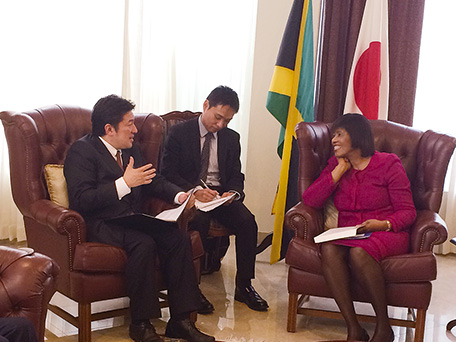
Then State Minister for Foreign Affairs Yasuhide Nakayama pays a courtesy call on Prime Minister of Jamaica Portia Simpson Miller in May 2015.
Latin American and Caribbean countries are often struck by natural disasters such as earthquakes, tsunamis, hurricanes, and volcanic eruptions. Therefore, Japan’s assistance to these countries, utilizing Japan’s knowledge and experience in the field of disaster risk reduction, has special importance. Japan provided reconstruction and development support to Haiti, which suffered catastrophic damage from the huge earthquake with a magnitude of 7.0 in January 2010. Japan has also provided assistance in anti-earthquake and anti-tsunami measures to the countries located in the Caribbean Sea and the countries bordering the Pacific Ocean. Furthermore, the Project on Capacity Development for Disaster Risk Management in Central America “BOSAI”, which aims to share knowledge of disaster risk reduction and reduce disaster risks at the community level, has achieved significant results in the Central American region.
In recent years, Latin America and the Caribbean have been attracting attention as a manufacturing base and market, and many Japanese companies are expanding their businesses to this region. After holding a training session on cardiac catheterization techniques* for physicians in Mexico in 2011, Japan has held the same training for physicians not only in Mexico but also in Argentina, Colombia, and Brazil since 2014. This training is expected to promote the dissemination of Japanese companies’ techniques across the Latin American and Caribbean region. In addition, from the perspective of laying the foundation for the economic development of Latin American and Caribbean countries, Japan has been actively implementing infrastructure development in the capital and regional areas.
Japan has been providing cooperation on a wide range of environmental issues in the region, including assistance to scientific and technological research on climatic phenomena, conservation of biodiversity, broad-range evaluation of carbon dynamics(Note 9) of Amazonian forests, and construction of waste disposal facilities. In the area of renewable energy, which has been receiving increasing attention in recent years, Japan has provided support for introducing solar power generation in many countries, and also supports the construction of geothermal power plants in countries such as Costa Rica.
Japan also provides various kinds of cooperation for Latin American and Caribbean countries in the medical and healthcare area. In the Central American region, Japan has provided technical assistance to eradicate Chagas disease, a parasitic disease specific to the region, and has been contributing to the reduction of infection risk. In Paraguay, Japan has provided assistance in the renovation of university hospitals and provision of medical equipment. In the area of sanitation, Japan also implements numerous projects to assist in the construction and improvement of water and sewer systems in various countries, including Peru, in order to ensure the provision of safe drinking water and to promote the recycling of domestic water in those countries.
Assistance in the area of education is extremely important for Latin American and Caribbean countries, as poverty still remains high and the educational budget is not sufficient in these countries. Japan has provided support for building educational facilities such as primary schools, as well as dispatching volunteers to improve the capacity of teachers. Such efforts are highly appreciated in these countries.
For Caribbean countries, Japan provides assistance towards their specific vulnerabilities as Small Island Developing States (SIDS), such as climate change and natural disasters, taking into account various needs which cannot be measured by per capita income alone. In the field of the environment and disaster risk reduction, Japan has been implementing projects such as a region-wide grant aid on climate change in the eight Caribbean countries and technical cooperation on disaster risk reduction. In the fisheries field, Japan has been contributing to promoting the sustainable use of limited living marine resources by improving facilities and dispatching experts.
One of the results of Japan’s many years of development cooperation can be seen in joint cooperation with Brazil, Mexico, Chile, and Argentina. These four countries have come to obtain the capacity to assist other countries, and achieved results in South-South Cooperation.* Japan has signed partnership programs with these countries. For example, Japan has worked together with Brazil to provide agricultural development cooperation in Mozambique. Japan also joined hands with Mexico to provide similar cooperation in Paraguay. In addition, Japan is providing assistance for the reconstruction process after the earthquake in Haiti in cooperation with Argentina, the Dominican Republic and other countries.
Japan has cooperated with the Central American Integration System (SICA),(Note 10) the Caribbean Community (CARICOM), and other regional organizations to formulate wide-ranging projects in order to achieve more effective and efficient development cooperation related to development issues that are shared throughout Latin America and the Caribbean.
Under public-private partnership (PPP), Japan has endeavored to introduce Japanese Integrated Services Digital Broadcasting-Terrestrial (ISDB-T) standards for terrestrial digital TV. By the end of August 2015, this system has been adopted by 13 Latin American countries. Japan has supported these countries by transferring technology and training experts to enable the smooth implementation of the system.
Moreover, Japan has provided more than $200 million in assistance to date for reconstruction efforts in Haiti, which was hit by the major earthquakes in 2010. Japan also continues to provide reconstruction support from a medium-to long-term perspective, with a focus on basic social services such as health, sanitation and education.
- *Cardiac catheterization
- The term refers to transradial cardiac catheterization. This method involves inserting a catheter through a large blood vessel in the wrist in order to expand the blood vessels to the heart that have narrowed or become blocked.
- *South-South Cooperation
- Cooperation provided by relatively advanced developing countries to other developing countries, utilizing their experiences in development and own personnel. It is conducted mainly by the scheme of technical cooperation in countries that have similar natural environments and cultural and economic circumstances, and are facing similar development challenges. In addition, support by donors or international organizations for cooperation between developing countries is referred to as “triangular cooperation.”
- Note 9: Changes in the carbon amount in a given period
- Note 10: Central American Integration System SICA: Sistema de la Integración Centroamericana
Cuba
Project for Extension and Diffusion of Technologies for Certified Rice Seed Production in the Central Zone of Cuba
Technical Cooperation Project (April 2012 – Ongoing)
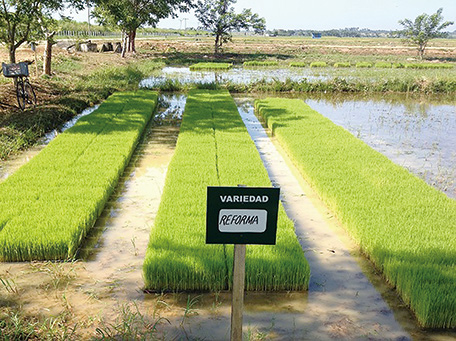
Seedlings grown under this project. (Photo: JICA)
Cuba is located in the Caribbean Sea and the country’s main food staple is rice. However, Cuba has achieved only 36% self-sufficiency in rice production. The rest of its rice is imported. Therefore, increasing Cuba’s self-sufficiency in rice production is one of the country’s important policy priorities.
To answer the request of Cuba, the Government of Japan has provided technical cooperation to improve Cuba’s rice cultivation yields. In order to improve yields, Cuba needs good-quality rice seeds of varieties that suit its climate and soil conditions. In addition, the rice must be grown using the right techniques.
Good-quality seeds are required to be disease-resistant, drought-resistant and high-yielding. Additionally, they must not be mixed in with other seeds or contaminants, and must germinate properly. Seeds that meet these requirements must be produced and then be disseminated to farmers as certified seeds by the government.
In 2012, Japan started a technical cooperation project to increase production of this certified rice in Cuba. The project was conducted in the five provinces of Cuba’s central region (Cienfuegos, Villa Clara, Sancti Spiritus, Ciego de Avila and Camaguey), which covers 40% of the country’s rice growing area.
As part of this project, training programs about demonstration farms for rice seed production have also been held in these five provinces. The program provides opportunities to agricultural extension workers and seed farmers, through a combination of lectures and fieldwork, to learn appropriate cultivation techniques, and operating methods for agricultural equipment, such as new rice transplanters. This project has also developed a system in which agricultural extension workers can provide efficient instruction to seed farmers.
Various manuals have also been compiled to ensure that techniques continue to be conveyed correctly, even after the project ends. These have been handed out to agricultural extension workers and seed farmers.
Japan’s assistance has helped spread techniques for producing certified seeds. It is hoped that this will significantly raise Cuba’s self-sufficiency in rice production. (As of August 2015)
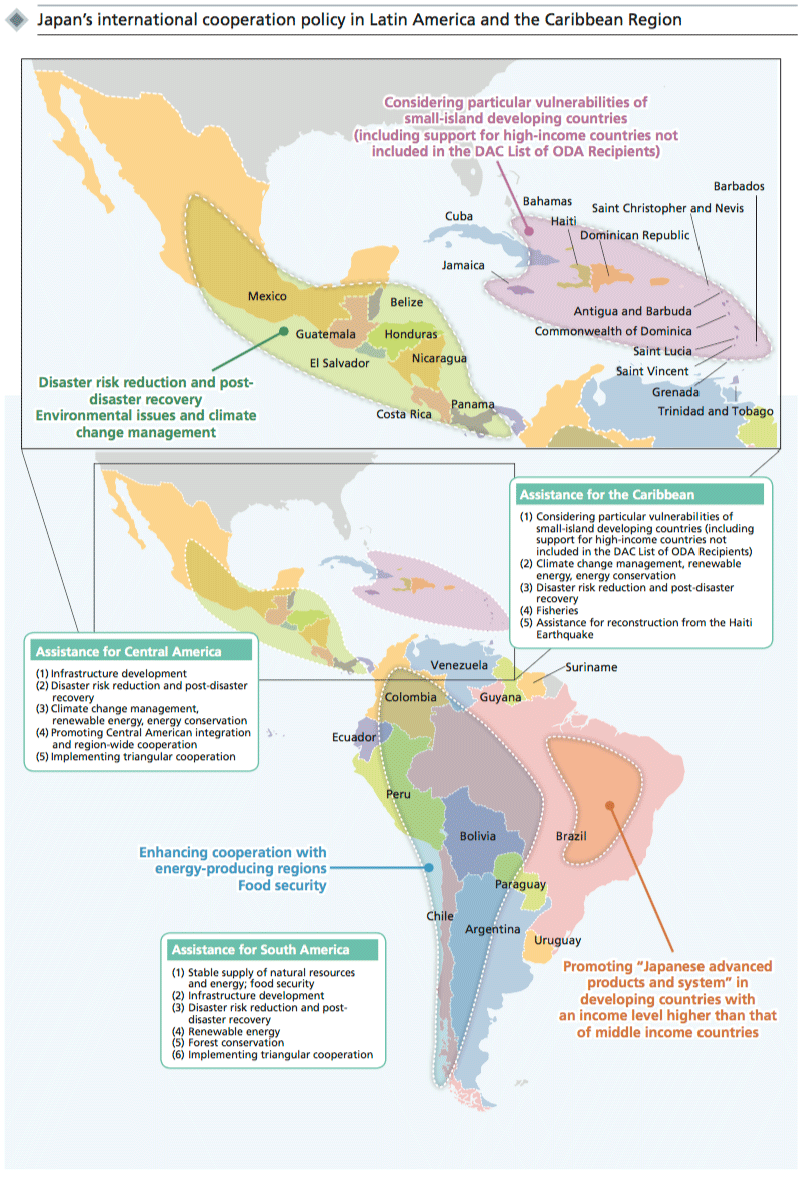
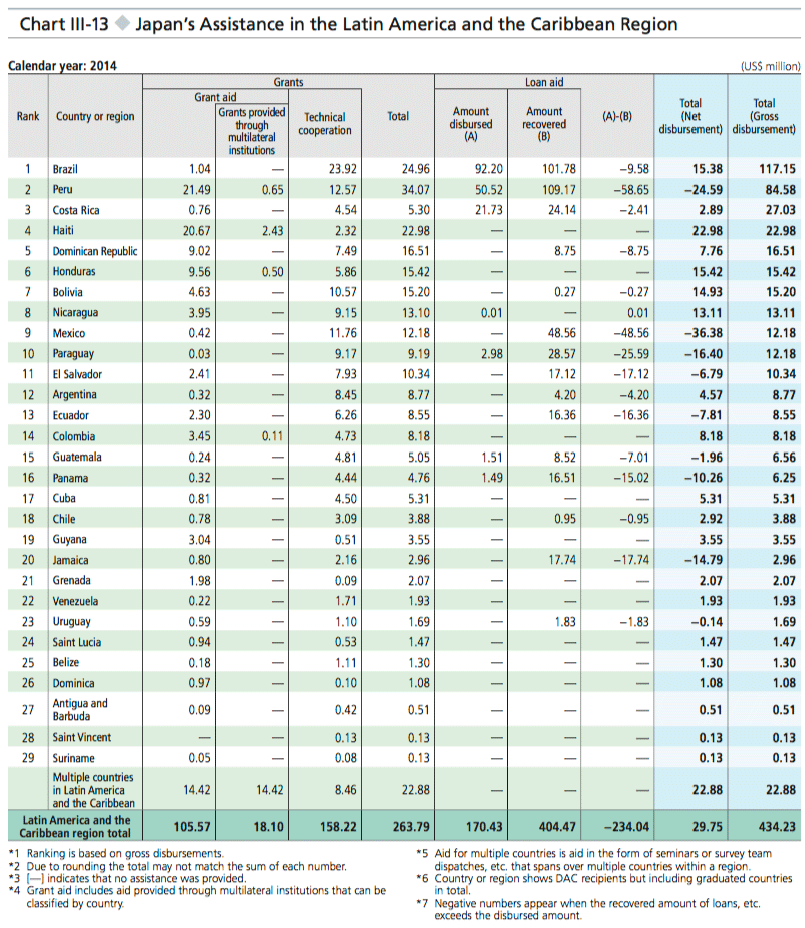
Mexico
Project for Automotive Supply Chain Development in Mexico
Technical Cooperation Project (October 2012 – Ongoing)
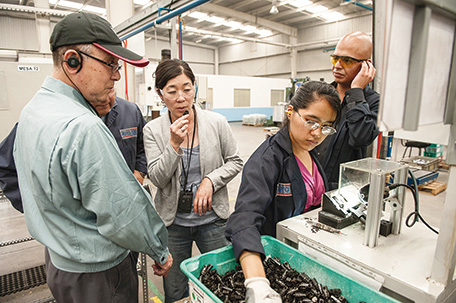
An automotive component manufacturing plant which has adopted the practices of Kaizen. (Photo: Kenshiro Imamura / JICA)
Mexico has high-quality labor at relatively low cost. The country is also located between the markets of North America and South America, which gives it an excellent geographic advantage. In addition, Mexico has free trade agreements (FTA) with many countries around the world. It has therefore become an increasingly important production hub for the automotive industry. Leading Japanese automakers have plants in Mexico as part of their global production network.
However, Mexico continues to face social disparities, and inequality and poverty are major problems that need to be solved. The development and promotion of industries that drive its economy are important in order to create jobs and develop the economy sustainably.
The automotive industry creates jobs for the assembly and manufacture of some 30,000 parts. However, Mexico’s auto-parts industry cannot still improve its quality, cost and delivery-times. Many automakers face difficulties in sourcing parts locally, after they set up operations in Mexico.
In light of this, at the request of the Government of Mexico, the Government of Japan has been providing technical cooperation for strengthening Mexico’s auto-parts supply chain.
A number of experts have been dispatched from Japan to Mexican states that have strong automotive industries, in order to help develop an integrated supply chain. Specifically, these experts have been teaching Mexican auto-parts suppliers how to analyze and improve their processes for providing better quality, cost and delivery-times. They have also built a database of auto-parts suppliers.
The Governments of Japan and Mexico jointly selected a number of secondary auto-parts suppliers that would learn how to analyze and improve their processes. Specific targets were established, and Japan and Mexico are supporting and monitoring the suppliers’ efforts to reach these targets. It is hoped that this will help the suppliers meet Japanese automakers’ quality, cost and delivery-time requirements.
Japanese experts also work together with ProMexico, Mexico’s trade promotion institution, and state governments, in order to create a database of auto-parts suppliers, which will promote business matching between companies in the automotive industry.
It is expected that Mexico’s automotive industry will further develop as a result of Japan’s development cooperation to help strenghthen Mexico’s supply chain. (As of August 2015)
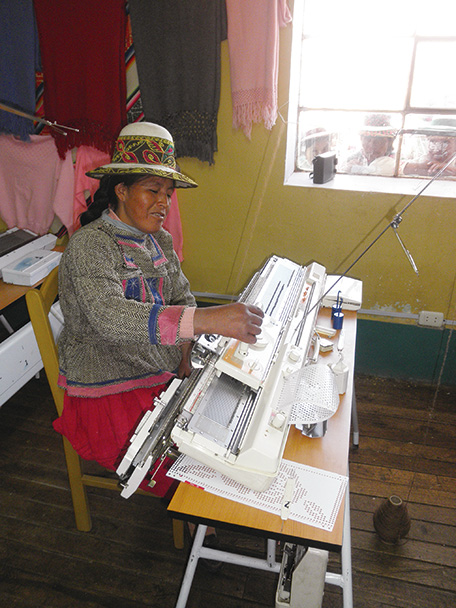
A local resident manufactures traditional fabrics using equipment provided by Japan at a textile processing factory in Cusco State in southeastern Peru. (Photo: José Sato/Embassy of Japan in Peru)
